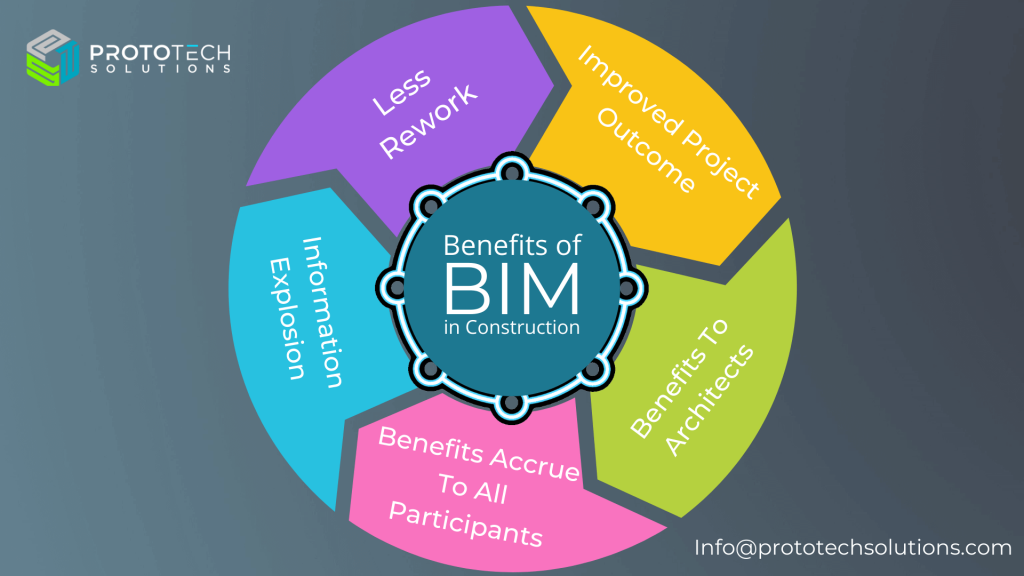Benefits of BIM Model for the Construction Industry
The phrases BIM Model and BIM are interchangeable. By utilising BIM-created models, AEC professionals will reap the numerous benefits associated with BIM.
Thus, it is critical to grasp the fundamental nature of BIM and how it has altered the way the construction industry functions today.
1. Less rework: Because the complete building’s BIM Model has been practically prepared, stakeholders and anybody else involved in the project will be aware of the project’s scope.
Apart from that, using these models, conflicts are settled prior to the start of building. This will save considerable time and money compared to the time and money required to remedy those clashes during construction.
2. Improved project outcome: After implementing BIM, the project owners and managers noticed an improvement in the project’s outcome, and not just in terms of cost-efficiency and time savings.
However, other additional factors contribute to a better project outcome as a result of BIM. Here, elements such as personal satisfaction, better understanding, and ease of explanation take precedence.
These are the aspects that also contribute to the project’s information flow being as fluid as possible.
3. Benefits to architects: Prior to BIM, architects were required to reconstruct designs and drawings on a regular basis. And this type of rework was necessitated by a number of factors.
Even worse was the hassle they had to go through to secure the client’s delight. However, with the advent of BIM and computer-aided design, everything has changed.
Architects may now easily modify a project model without spending hours on the pen and paper approach.
4. Benefits accrue to all participants: Not only architects, but BIM has simplified the work of fabricators, contractors, mechanical and electrical engineers, owners, and structural engineers.
All those working in the aforementioned fields can comprehend the BIM Model with only a basic understanding of it. Fabricators will be familiar with the material to be used, as well as with the dimensions and other types of measures
MEP engineers can interact with the building’s structural designer to ensure proper coordination. Manufacturers will be informed in advance of the material needs and delivery timetable.
Overall, the BIM Model benefits every department involved in the project.
5. Information explosion: Today’s project engineers and technicians have access to a wealth of data and information, owing to the BIM Model.
BIM allows for the creation, review, and sharing of any sort of construction drawing.

Fig: BIM Model for the Construction Industry
What Does the Future Hold for BIM?
BIM will be adopted by practically every architectural and construction firm in the future. Those who are not currently using BIM are required to do so in order to prepare the blueprint for the construction project.
The majority of developed countries, including the United States, the United Kingdom, Japan, and Germany, have already implemented BIM in their building industries.
On the other hand, developing countries such as India and China are attempting to comprehend and master BIM. With widespread adoption in the worldwide AEC industry, BIM will become one of the most widely utilised platforms for application in all spheres of activity.
Conclusion
The BIM model is a complex component of the architecture and engineering (AEC) sector. It possesses the ability to propel the building sector forward. BIM is advantageous in practically every aspect of a building’s operation.
It could be as simple as placing raw material orders to as complex as building components and various elements in an impossible situation. And to enable this, BIM can be used to reinvent collaboration across all disciplines and stakeholders.
The ProtoTech Advantage
ProtoTech delivers a wealth of knowledge and skill in both establishing information management processes and performing BIM projects, as well as authoring projects in accordance with company, national, and worldwide standards.
From data capture via 3D scanning and photogrammetry to point cloud processing of the data acquired via these methods, to BIM and reality modelling based on that data, we have you covered. We are also capable of performing structural analysis using Revit3D Drafting, which is also utilised for architectural and mechanical design.

